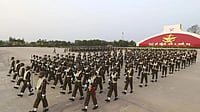24x7. Something you'd associate with phone-banking, pizza, even perhaps police, but not infrastructure in India. Especially water supply. Global statistics confirm the cynicism. No city in India (or South Asia) can boast a round-the-clock water supply, when even dozens of African cities like Dakar and Kampala flaunt it. Only a few Indian water boards recover O&M costs and none have performance indicators comparable to global standards.
On an average, says a recent TISS study, 65 per cent of households in Indian cities are water-deficient, clocking an average of 5.6 hours of supply per day. WHO puts minimum water needs at 100 litres per capita per day (pcpd); the Indian norm is 40.
More important is the duration of the supply. Cities like Delhi and Mumbai supply water 4-5 hours a day on an average, some cities like Hyderabad deliver water every other day. Yet, water resources may be abundant, ranging from 341 litres pcpd in Goa to 105 litres in Bharatpur (see chart). Says Junaid Ahmed, sector manager, social development, World Bank: "The traditional explanation given for the intermittent system is lack of resources. But there is little correlation between the two. In Africa, cities with 110 litres offer 24x7 water; European cities provide around 150, while Delhi supplies 240 litres!" But this is only an average—pcpd being total supply divided by population—and distribution is heavily skewed in favour of Lutyens' babucrats and politicos.
Urban water supply assumes importance as by 2020 around half of Indians will be living in cities. To tackle the leaking-bucket malaise once and for all, some civil servants in Delhi and Bangalore are working hard to make 24x7 supply of safe, potable water a reality. The Karnataka Urban Water Sector Improvement Project (Kuwasip), the Greater Bangalore Water Supply and Sanitation Project (GBWASP) and the Delhi Water Supply and Sewerage Project (DWSSP) will, if they succeed, change the face of India's most beleaguered infrastructure sector forever.
The common thread that binds all is the recognition that India's water problem is not a supply but a resource management problem. Over time, poor management of supply and distribution has worsened the situation even in Delhi which has historically had abundant water. Result: most water utilities are saddled with huge losses and the states with subsidies. India spends at least $1.1 billion a year on water sector subsidies (including rural irrigation) and 98 per cent of these come from state budgets, says Meiko Van Ginneken, water and sanitation specialist at the World Bank in Washington.
The projects also aim to make people pay for quality water, and not waste water. In Delhi, non-revenue water (including free water) is close to 60 per cent and leakage is 40 per cent. Even Planning Commission chairman M.S. Ahluwalia says water is not a public good. It's more of an economic good in public hands around the world (the only exception is the UK, which privatised water two decades ago). The Delhi Jal Board, for instance, has faced flak for raising tariffs (in December 2004) even before spadework started on the project. But there is no such thing as free water. Even if water is not priced, its access is. Says Suresh Babu of the Centre for Science and Environment: "We have always supported judicious water pricing. Consumers must pay for treated and piped supply."
In the past decade, as municipalities have increasingly defaulted on supply and quality, citizens have turned to costly alternatives. The packaged water industry is now a Rs 10,000-crore-and-rising industry. Then there is the expensive, on-line household water treatment and supply boosting equipment industry. A recent study in six A-class cities (Indore, Nagpur, Jaipur, Ahmedabad, Bangalore and Chennai) notes that in three of these, the contribution of groundwater towards meeting the city's domestic and municipal water requirements ranges between 72 per cent and 99 per cent. Several also have a thriving tanker water economy, supplying around 14-55 million litres per day. Many South Delhi residents and slum areas perpetually live off tankers.
Forget those who can afford such spending on water, even the poorest pay for water in terms of substantial health cost, and a waste of time queuing up or trudging long distances to fetch water. And the rich who often waste water get unnecessary subsidies. The subsidy for water connection and actual use is $17 per month for the richest decile in Bangalore, says Van Ginneken. Adds K.P. Krishnan, MD, Karnataka Urban Infrastructure Development and Finance Corporation, the nodal agency for the Karnataka projects: "We have done an 8,000-household study on quality and willingness to pay. Almost 94 per cent of the water is unfit for consumption. Suburban water is contaminated. Naturally, then, people are willing to pay for safe tap water."
Yet, despite the seemingly lucrative business opportunities, private firms have rarely come forward to participate in the sector. They found it a risky investment because of a) high political and regulatory uncertainty, b) low returns and long payback periods, c) low tariffs, subsidy and affordability issues, d) imperfect basic business data (pipes are all underground) and the political dimensions of water and user charges. As a result, even the World Bank—which in the '90s was encouraging the case for privatisation of water utilities in developing countries it lent to—has of late adopted a pragmatic, result-oriented approach: regulation and contracting out rather then privatisation, and emphasis on service delivery and cost recovery.
The Bank is funding Kuwasip and the Delhi project to the extent of $39.5 million and $140 million, respectively. The operating agencies' contributions are $11.6 million by kuidfc and $106 million by Delhi Jal Board. Both are high-level technical and management assistance programmes aimed at plugging leakages and improving service delivery—there is no downsizing of staff, no radical restructuring, except of mapping, engineering, building and distribution management.
Kuwasip (loan sanctioned on April 8) is being implemented in parts of Belgaum, Gulbarga and Hubli-Dharwad towns of Karnataka in the first four-year phase, to be extended to the rest of the area in the next phase covering less than two lakh people. Compagnie Generale Des Eaux Seureca JV was selected by competitive bidding for the performance-based contract. Out of eight works packages, bids have been invited for six. The first two years will be crucial as service and willingness to pay will be tested.
The Delhi project, too, is a small leap in the dark. The South II and III zones—the most water-scarce regions—selected as test cases have a population of two lakh and will be catered to by the Sonia Vihar plant, expected to go online September.
Says Rakesh Mohan, CEO, Delhi Jal Board: "Adequate water supply is a misnomer. I will change the supply from intermittent to sustained, but with full metering and graded tariffs. I'll give you 6,000 litres a month free, no uncertainty, no contamination, but consumers must promise me no storage, no boosters, no underground reservoir." The DJB's balancesheet is loaded with a huge loss of Rs 5,000 crore, yet its tariffs are still the lowest among comparable cities.
Thanks to the project (the WB loan will come through in November), DJB expects to eliminate government subsidies in the fifth year.Mapping and prequalification for award of the management contract is over and work on engineering and building contracts will start soon. By September '06, the first results may be visible.
But the most interesting experiment may be incubating in Greater Bangalore, a state and public-funded greenfield project for piped supply of water in an area mostly serviced by borewells, an area bigger than the city itself and housing all the new developments and industrial showpieces. The beneficiary capital contribution is 35 per cent of the entire project cost of Rs 340.55 crore—it is the residents who want connections who have contributed and thus become stakeholders. "The fees range from Rs 2,500 to Rs 15,000. We have already collected Rs 40 crore," says a happy Krishnan. Of course, some money will be raised through government-guaranteed loans, too.
An MoU signed with the Ramesh Ramanathan-headed NGO Janagraha will ensure public scrutiny and appraisal of the progress, even citizen's participation at every stage. There is a lifeline programme for the poor. Even here, the O&M will be done by a private operator.
Ninety per cent of the cost in a water system is in distribution. So, efficient management will remain the key to solving urban water supply problems. The world over, cities are buying water from farmers (in China and the US), from other cities (Los Angeles, Santiago), even other countries (Singapore buys its entire water from Malaysia). Indian states mostly use free water, often at the cost of huge disputes. It only has international water rights. The future then lies in putting in place domestic water rights to ensure sustained supply.
Well, Well... India Is On The Drip
Three projects aim to change the pathetic water supply situation in India and provide water round the clock

Well, Well... India Is On The Drip
Well, Well... India Is On The Drip
Published At:
MOST POPULAR
WATCH
MORE FROM THE AUTHOR
PHOTOS
×





















